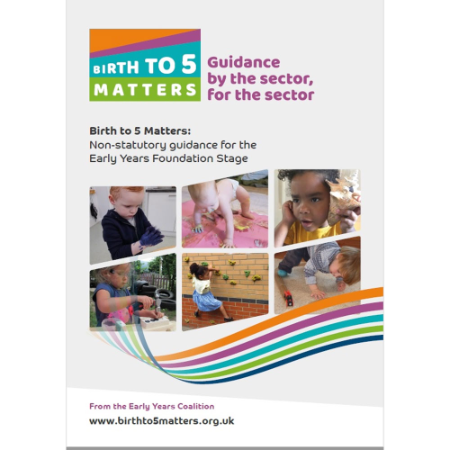
Birth to Five Matters: what is it?
What is Birth to Five Matters?
According to Nancy Stewart – Early Years consultant, Project Lead for Birth to Five Matters – Birth to Five Matters is a tool to help early years practitioners in England bring the EYFS to life in their settings. It has been created with the sole purpose of supporting practitioners to implement the EYFS in a pedagogically sound, principled and evidence-based way. It is a resource that settings and practitioners can draw on as they decide how best to meet the needs of their particular children and families.
The EYFS statutory framework itself is only a skeleton, containing just a few requirements in terms of children’s development and learning. It lists the seven areas of learning and development and describes in very broad terms the educational programmes — the kinds of activities and experiences that must be offered from babies onward. It also lists the Early Learning Goals, but those are an assessment to be used only at the end of the reception year and the EYFS states clearly that they should not be used as a curriculum.
So practitioners must use their professional judgement to put the flesh on the bones of the EYFS, by deciding all the rich detail of their practice. In their settings practitioners decide:
- How they work with parents
- What being a key person means
- How they understand children’s development
- Learning as babies, toddlers and young children
- How they link with their community
- What is most important to focus on including perhaps children’s emotional wellbeing, confidence, curiosity and motivation.
Settings decide for themselves:
- How they support children’s play
- How they develop environments and use the outdoors.
In carrying out the EYFS duty to support every child, practitioners use their professional judgement to decide how best to understand what children know, understand and can do, and what to do next to support and extend development and learning.
Birth to Five Matters offers information and guidance about all these professional decisions and many more. Every aspect of the learning and development requirements in statutory EYFS is reflected in Birth to Five Matters, so practitioners can be confident that if they use Birth to Five Matters as a guide they will find support to fully implement the EYFS.
Many settings will be familiar with the government guidance Development Matters . Both Birth to Five Matters and Development Matters are non-statutory guidance, which means there is not a requirement to use them. Ofsted will not be expecting settings to use any particular guidance in developing their work, and it is completely up to settings and practitioners to have a look at what is available and decide what will best help them in their practice.
Who has put Birth to Five Matters together?
Birth to Five Matters was created by experts in early childhood development and learning and offers well-evidenced suggestions for ways adults can support children to flourish. The guidance was produced by the Early Years Coalition, a partnership of 16 major early years sector organisations. One hundred experts, both academics and practitioners, worked together to share their research and practical experience to produce the guidance.
Why is Birth to Five Matters important?
To help children make the best progress, it is important for practitioners to understand child development, how children learn, and the role of adults in supporting and extending their learning. Birth to Five Matters offers detailed information about typical trajectories in development and learning across all areas, from babies to the end of the EYFS.
In each area and at each stage, the guidance uses the familiar layout of Unique Child – Positive Relationships – Enabling Environments to suggest ideas for what adults might do to foster children’s learning. These are not a ‘how to’ recipe, but offered as prompts for practitioners to consider what is most appropriate for their individual children.
Observing development
Birth to Five Matters completely agrees with the push from the government and Ofsted to stop the tick-list approach to assessment and over-use of record keeping. Birth to Five Matters is clear about the process of observing children, reflecting on what it says about a child’s development, well-being and approaches to learning, and then using professional judgement to decide how to respond – without using tick lists or writing everything down.
Although there are typical patterns of development as children grow older, each child is different and should not be expected to show particular skills at prescribed ages. Following consultation with practitioners, Birth to Five Matters developed a different approach to age/stage links. The grids in the Areas of Learning and Development are labelled as ranges rather than age bands. There is, however, a ‘key’ showing how the ranges link to typical ages, which can be a reference to see whether a child’s development is on track, or whether additional support might be needed.
The guidance is available both in printed form and in an online interactive version with additional resources, case studies and references so practitioners can dig deeper if they wish.
This piece originally appeared in the spring 2021 edition of Nursery News magazine.
- Birth to five
- EYFS
Similar Articles
Top tips: New year new energy - supporting your team

Early years activity: Cosy calm den



